ELECTRICITY AND CIRCUITS for Class 6 SCIENCE
Introduction
Jaisa ki hamare chapter ka name hai “Electricity and circuits” toh sabse pehle hum jante hai ki electricity kya hoti hai.
Electricity ko hum hindi mein ‘bijli’ kehte hai aur aaj-kal hum electricity ka use apne bahut saare works mein karte hai jaise water ko tank mein bharne ke liye hum electric pumps ka use karte hai; homes, offices, markets, etc. mein lighting ke liye hum electricity ka use karte hai, iske alawa aur bhi bahut saare works mein hum electricity ka use apni daily life main karte hai.
Iss chapter mein hum janege ki electricity kaise use ki jati hai, electrical components kya hote hai, yeh kaise use kiye jaate hai, etc. Iss chapter mein hum electrical components jaise electric cell, electric switch, conductors, insulators ke baare mein janege aur iss process ko bhi janege ki inko electric circuit banane ke liye kaise use kiya jata hai. Iss chapter ko padhne ke baad hamein daily life mein hamare mind mein chalne wale bahut saare questions ke answer mil jayenge aur hum jaan jayenge ki hamare switch off ya off karne par bulb on ya off kaise ho jata hai, aisa kyon hota hai ki kabhi-kabhi switch on karne par bhi bulb on nahi hota, etc. Inn sabhi ki details ab hum iss chapter mein padhenge.
Electric cell
Electric cell ek device hota hai jo apne andar stored chemical energy ko electrical energy mein convert karta hai.
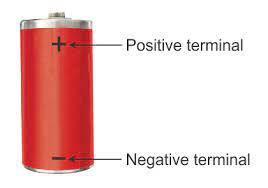
Electric cell mein do terminals hote hai, Positive (+) aur negative (-). Jis side metal cap hoti hai woh cell ka positive terminal hota hai aur jis side metal disc hoti hai woh cell ka negative terminal hota hai. Cell mein chemical stored hota hai aur jab tak chemical present hota hai tab tak cell work karta hai aur usko electricity mein convert karta hai aur jab iska sara chemical use ho jata hai tab yeh work karna band kar deta hai aur hamein isko replace karna padta hai. Electric cells ko hum alarm clocks, wristwatches, transistor radios, cameras, etc. mein use karte hai.
Note:
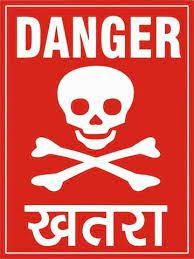
A Bulb Connected To An Electric Cell
Bulb: Bulb ek electrical component hai, isko hum sab lighting ke liye use karte hai.
Ab hum dekhte hai ki bulb glow kaise karta hai?
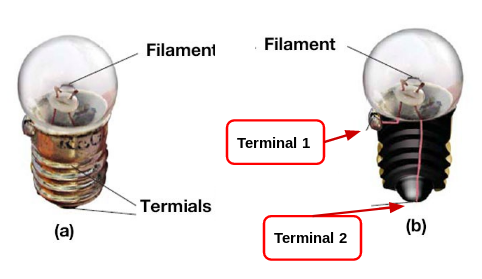
How to connect a bulb to an electric cell?
Ab hum ek activity perform karenge aur dekhenge ki electric cell ko bulb se kaise connect kiya jata hai.
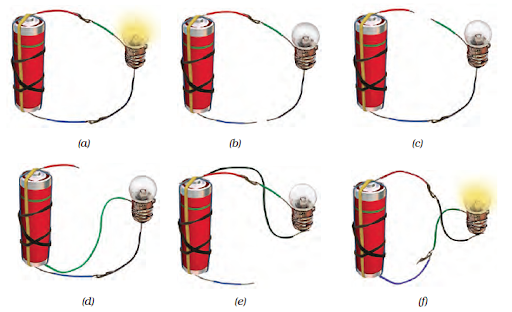
An Electric Circuit
Electric circuit electrical components ka ek path hota hai jiske through electric current flow karta hai.
Electric circuit electricity ko flow karne ke liye ek complete path provide karta hai lekin isme current sirf tabhi flow kar sakta hai jab circuit closed ho, open circuit mein path break ho jata hai aur current flow nahi karta.
Circuit do type ke hote hai-
Open circuit: Agar electric circuit ke path mein koi bhi gap ho aur bulb glow na kare toh aise circuit ko hum open circuit kehte hai.
Closed circuit: Electric current ka ek aisa path jisme koi bhi gap nahi hota aur current ke continuous flow se bulb glow karta hai, usko closed circuit kehte hai.
How current flows in an electric circuit?
Electric circuit mein hum cell ke terminals ko electric wires ki help se bulb se connect karte hai. Jab hum iske terminals ko wire se connect kar dete hai toh filament mein se current pass karta hai aur bulb glow karta hai. Electric circuit mein current electric cell ke positive terminal se negative terminal ki side move karta hai.

Lekin kabhi kabhi cell se connect karne ke baad bhi bulb glow nahi karta, aisa kyon hota hai?
Aisa tab hota hai jab bulb fused hota hai.
Ab yeh fused bulb kya hota hai?
Agar bulb ki koi filament ya supporting wire break ho jati hai toh current ka path break ho jata hai aur woh glow nahi karta, aise bulb ko hum fused bulb kehte hai. Hum niche figure mein bhi dekh sakte hai ki iss bulb ki filament break ho gayi hai, toh agar iss bulb ko hum circuit mein lagayenge toh yeh glow nahi karega.
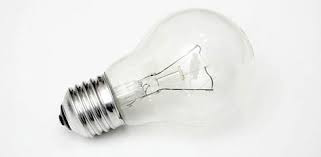
Electric switch
Electric switch ek simple device hota hai jo circuit ko complete karta hai ya break karke current ke flow ko stop karta hai. Apne homes, offices, etc. mein hum bulb aur other devices ko on ya off karne ke liye electric switch ka use karte hai.
Switch ke liye do conditions possible hoti hai- open switch aur closed switch.
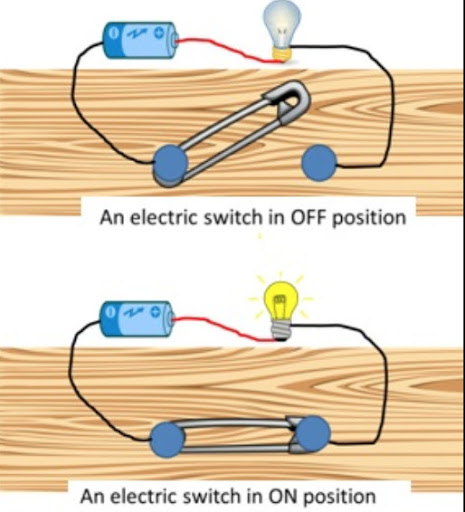
Electric Conductors And Insulators
Conductors: Aise materials jinme electric current flow kar sakta hai, unko conductors kehte hai. Eg- Key, Iron nail, etc. jo bhi objects metal se baney hote hai woh sabhi conductors hote hai.
Insulators: Aise materials jo electric current ko pass nahi karne dete aur hamare circuit ko break karte hai unko insulators kehte hai. Eg- Rubber, plastic, wood, air, glass, etc.
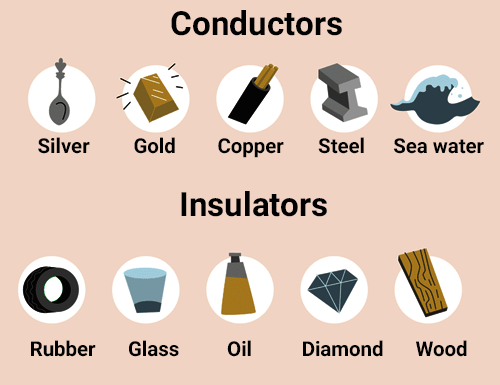
Importance of conductors and insulators
Hamare liye conductors aur insulators dono hi bahut important hote hai kyonki conductors circuit ko complete karne mein help karte hai aur insulators circuit mein used devices ko cover karne mein help karte hai taki hamein electric shock na lage.
Note: Hamari body electricity ki good conductor hai isliye hamein electrical appliances ko use karte time careful rehna chahiye nahi toh hamein shock bhi lag sakta hai.
POINT 1
Electric cell: An electric cell is a device, which converts chemical energy into electrical energy.
Filament: A filament is the thin wire inside a light bulb that emits light when heated by an electric current.
Electric circuit: Electrical circuit is a path of electrical components through which the electric current flows.
Conductor: An electrical conductor is defined as material that allow electricity to flow through them easily.
Insulator: A material or an object that does not easily allow heat, electricity, light, or sound to pass through it.
SUMMARY
Electric cell is a source of electricity.
An electric cell has two terminals; one is called positive (+ ve) while the other is negative (– ve).
An electric bulb has a filament that is connected to its terminals.
An electric bulb glows when electric current passes through it.
In a closed electric circuit, the electric current passes from one terminal of the electric cell to the other terminal.
Switch is a simple device that is used to either break the electric circuit or to complete it.
Materials that allow electric current to pass through them are called conductors.
Materials that do not allow electric current to pass through them are called insulators.